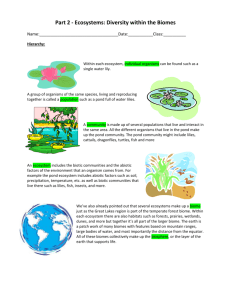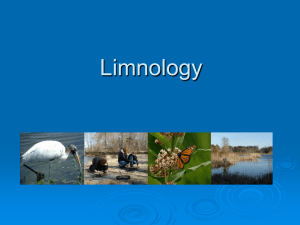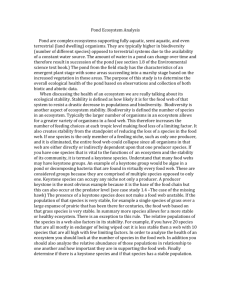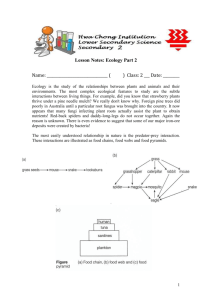7th grade, Ecology
advertisement
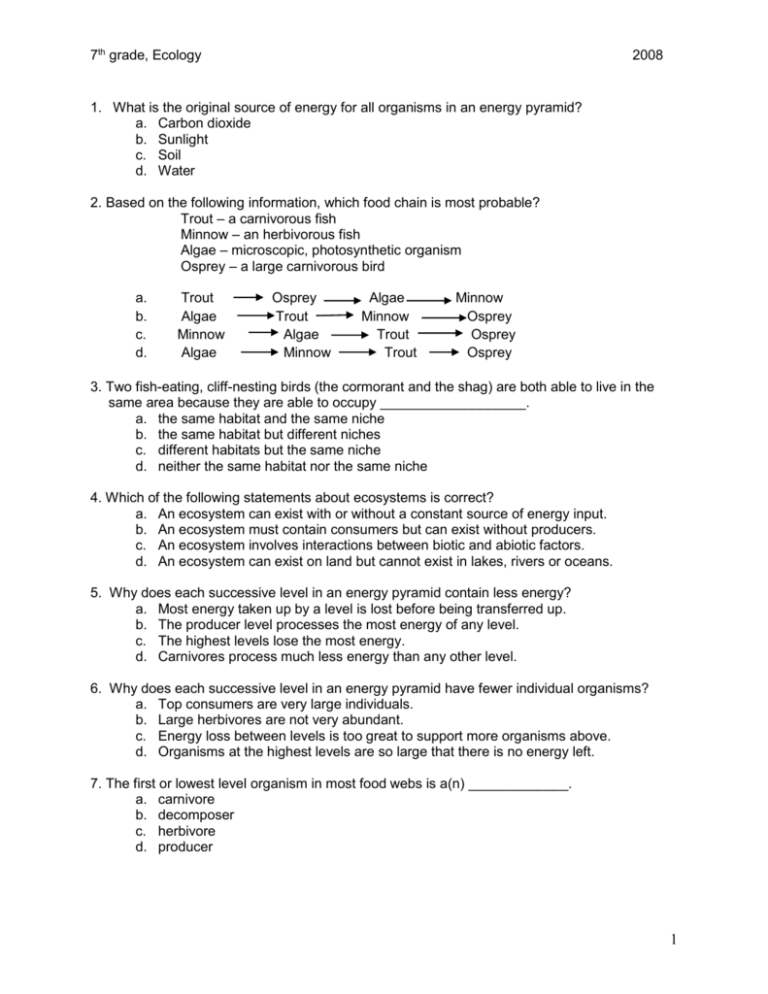
7th grade, Ecology 2008 1. What is the original source of energy for all organisms in an energy pyramid? a. Carbon dioxide b. Sunlight c. Soil d. Water 2. Based on the following information, which food chain is most probable? Trout – a carnivorous fish Minnow – an herbivorous fish Algae – microscopic, photosynthetic organism Osprey – a large carnivorous bird a. b. c. d. Trout Algae Minnow Algae Osprey Trout Algae Minnow Algae Minnow Trout Trout Minnow Osprey Osprey Osprey 3. Two fish-eating, cliff-nesting birds (the cormorant and the shag) are both able to live in the same area because they are able to occupy ___________________. a. the same habitat and the same niche b. the same habitat but different niches c. different habitats but the same niche d. neither the same habitat nor the same niche 4. Which of the following statements about ecosystems is correct? a. An ecosystem can exist with or without a constant source of energy input. b. An ecosystem must contain consumers but can exist without producers. c. An ecosystem involves interactions between biotic and abiotic factors. d. An ecosystem can exist on land but cannot exist in lakes, rivers or oceans. 5. Why does each successive level in an energy pyramid contain less energy? a. Most energy taken up by a level is lost before being transferred up. b. The producer level processes the most energy of any level. c. The highest levels lose the most energy. d. Carnivores process much less energy than any other level. 6. Why does each successive level in an energy pyramid have fewer individual organisms? a. Top consumers are very large individuals. b. Large herbivores are not very abundant. c. Energy loss between levels is too great to support more organisms above. d. Organisms at the highest levels are so large that there is no energy left. 7. The first or lowest level organism in most food webs is a(n) _____________. a. carnivore b. decomposer c. herbivore d. producer 1 7th grade, Ecology 2008 8. Use the diagram of the aquarium below. Which statement is correct? a. b. c. d. The community within this ecosystem consists of seven guppies and one catfish. The energy source for this ecosystem is the gas from the air stone. A population within this ecosystem is the three snails. The guppies and snails occupy the same niche. 9. Streams that feed a pond dry up and the pond therefore dries up too. The pond is surrounded by a beech/maple forest. What will likely happen to the pond area if the streams stay dry for another year? a. A beech maple forest will replace the former pond. b. The area previously covered by a pond will not change. c. The pond area will fill in with sediment. d. Vegetation will start to grow in the former pond area. 10. The chart below lists four groups of factors relating to an ecosystem. Group A Sunlight Green plants Rainfall Consumers Gases Group B Sunlight Climate Rainfall Minerals Gases Group C Sunlight Green plants Rainfall Consumers Gases Group D Sunlight Rainfall Consumers Producers Water Which group contains only abiotic factors? a. b. c. d. Group A Group B Group C Group D 11. Which 2 factors are abiotic limiting factors that affect organisms in a desert biome? a. b. c. d. Little rainfall and wide variation in daily temperature Few producers and not a lot of shade Below freezing cold nights and wet days Sand storms and courtship behavior 2 7th grade, Ecology 2008 12. Which statement best explains section X of the graph? a. b. c. d. Biotic factors became more important than abiotic factors. Immigration began to exceed emigration. A decrease in the birth rate may have occurred. More food became available to the bird population. 13. The diagram represents an energy pyramid. At each successive trophic level from A to D, the amount of energy available to the next higher level a. b. c. d. increases decreases increases, then decreases remains the same 14. This graph shows how the numbers of predator (the paramecium) and prey (yeast cells) change over time. Why does a predator population minimum occur on days 5 and 12? a. b. c. d. There were too many prey in the preceding few days. A limiting factor has become important. The predator population responds only to excess numbers of prey. The population of prey is rising, but not quite fast enough. 3 7th grade, Ecology 2008 Base your answers to questions 15 and 16 on the information below: Analysis of a sample taken from a pond showed variety in both number and type of organisms present. The data collected are shown in the table below. Data Table Number Present Type of Organisms Frogs 40 Bass 2 Phytoplankton 1000’s Insect larvae 100’s 15. If the frogs feed on the insect larvae, what is the role of the frogs in this pond ecosystem? a. Herbivore b. Parasite c. Consumer d. Host 16. Which diagram best represents the organisms arranged as an energy pyramid? A. C. Bass B. Phytoplankton Frogs Insect Larvae Insect Larvae Frogs Phytoplankton Bass Bass D. Insect Larvae Insect Larvae Phytoplankton Frogs Frogs Phytoplankton Bass 17. Several years after a building was torn down and the ground cleared, grasses were the first things to thrive in the area for several years because a. Predators could not find suitable habitat there when it was bare. b. The soil characteristics could not yet support bushes or trees. c. Producers must be present first before any herbivores or carnivores. d. There were too many open, unoccupied niches in the area for consumers. 18. Which statement best explains why a food web is a more realistic representation of nutritional patterns than a straight food chain? a. b. c. d. Energy always flows from the consumers to the producers. The amount of energy available at each higher trophic level increases. Most carnivores only consume individuals from one species of organism. Practically all species are consumed by or feed on more than one species. 4 7th grade, Ecology 2008 19. What would be a direct effect in the community below if the wolves and the mountain lions were removed? a. b. c. d. There would be fewer hawks. There would be more grass and trees. There would be more moose and elk. There would be no change in the community. 20. Long-term environmental change includes all of the following EXCEPT a. normal increasing amounts of wind during springtime each year. b. having fewer herbivores with each passing year. c. more deer each year. d. slightly warmer average temperatures each year. 5 7th grade, Ecology 2008 Answer Key: 1. b 2. d 3. b 4. c 5. a 6. c 7. d 8. c 9. d 10. b 11. a 12. c 13. b 14. c 15. c 16. a 17. b 18. d 19. c 20. a 6
